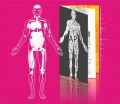A cure for dry eye could be a blink away
RIT mathematics professor studies the dynamics of tears
2014-05-28
(Press-News.org) A treatment for dry eye—a burning, gritty condition that can impair vision and damage the cornea—could some day result from computer simulations that map the way tears move across the surface of the eye.
Kara Maki, assistant professor in Rochester Institute of Technology's School of Mathematical Sciences, contributed to a recent National Science Foundation study seeking to understand the basic motion of tear film traversing the eye. "Tear Film Dynamic with Evaporation, Wetting and Time Dependent Flux boundary Condition on an Eye-shaped Domain," published in the journal Physics of Fluids on May 6, is an extension of Maki's doctoral research under her thesis advisor and co-author Richard Braun, professor in the University of Delaware's Department of Mathematical Sciences.
"We're hoping if we can understand better the basic dynamics of the tear film, then we can start to understand what goes wrong if you have dry eye and start to think about potential cures by studying simulations," Maki said.
Dry eye is a common condition without a cure. Many causes, including the aging process, contribute to discomfort resulting from either a lack of tears or tears that evaporate too quickly. In the United States alone, nearly 5 million people age 50 and older suffer from dry eye, according to the National Eye Institute, part of the National Institutes of Health. Women are predominantly afflicted with the condition, with more than 3 million diagnosed with dry eye due to hormonal changes associated with menopause. Treatment to alleviate symptoms includes eye drops and temporary or surgical plugs to stopper tear ducts at the inner corners of the eyes and retain fluid.
To understand dry eye, Maki had to begin with the physics and chemistry of tears. Tear film consists of a layer of water sandwiched between an oily layer of lipids on the outside to prevent evaporation and an inner mucous layer to spread the water over the eye.
Kara developed a mathematical model to simulate the direction tear film travels when entering the eye from the lacrimal glands above the upper eyelid. Using the software program Overture, she recreated the flow of tears on the surface of an open eye, moving from the upper corner and draining through the ducts at the opposite corner.
"One thing we were able to find is that when your eyes are open, the tears get thin right along the edge of the eye, and that is referred to as the 'black line,'" Maki said. "That has been seen clinically and can be reproduced in our simulations."
The tears, Maki explains, climb up the eyelid and join a column of fluid that travels along the lids. Lower pressure sucks the fluid into the meniscus and away from the center, creating the black line and dry spots in the tear film that can compromise vision and irritate the cornea.
Maki saturated the eye with liquid to penetrate the black line. She wanted to know if the fluid would travel down the front of the eye and relieve the thinning of the tear film.
"We found that we had to really flood the eye in our simulations. The fluid would rather travel in the meniscus," Maki said. "It splits traveling along the upper lid and the lower lid. We confirmed that blinking is necessary to stop this thinning from happening. Every time you blink, the tear film gets repainted on the front of your eye. It's important to have smooth tear film for optical quality."
The next step for Maki and the team led by Braun is to simulate the dynamics of tear films in a blinking eye.
"The nice thing about having a model is that you can make unrealistic things happen," Maki said. "For example, we can flood the eye and see where the tears go. Or we can look at what happens when the drainage holes are plugged. Where does the fluid go? You can start to explore these things in a safe way."
INFORMATION:
In addition to Maki and Braun, the dry-eye team includes Longfei Li, William Henshaw and P.E. King-Smith.
ELSE PRESS RELEASES FROM THIS DATE:
Antarctic ice-sheet less stable than previously assumed
2014-05-28
The first evidence for massive and abrupt iceberg calving in Antarctica, dating back 19,000 to 9,000 years ago, has now been documented by an international team of geologists and climate scientists. Their findings are based on analysis of new, long deep sea sediment cores extracted from the region between the Falkland Islands and the Antarctic Peninsula. The study in the May 28, 2014 issue of Nature bears witness to an unstable Antarctic ice sheet that can abruptly reorganize Southern Hemisphere climate and cause rapid global sea level rise.
"One of the iceberg events ...
Filling in the gaps on the protein map
2014-05-28
By cataloging over 18,000 proteins, researchers from TUM have produced an almost complete inventory of the human proteome. This information is now freely available in the ProteomicsDB database, which is a joint development of TUM and software company SAP. The database includes information for example on the types, distribution, and abundance of proteins in various cells and tissues as well as in body fluids.
The investigations show that, on the one hand, around 10,000 proteins are concerned with housekeeping processes in many different places. On the other hand, it was ...
Zeroing in on the proton's magnetic moment
2014-05-28
As part of a series of experiments designed to resolve one of the deepest mysteries of physics today, researchers from RIKEN, in collaboration with the University of Mainz, GSI Darmstadt and the Max Planck Institute for Physics at Heidelberg, have made the most precise ever direct measurement of the magnetic moment of a proton.
The work, published in Nature today, seeks to answer the fundamental question of why we exist at all. It is believed that the Big Bang some 13 billion years ago generated equal amounts of matter and antimatter-which annihilate when they collide-and ...
Extensive cataloging of human proteins uncovers 193 never known to exist
2014-05-28
Striving for the protein equivalent of the Human Genome Project, an international team of researchers has created an initial catalog of the human "proteome," or all of the proteins in the human body. In total, using 30 different human tissues, the team identified proteins encoded by 17,294 genes, which is about 84 percent of all of the genes in the human genome predicted to encode proteins.
In a summary of the effort, to be published May 29 in the journal Nature, the team also reports the identification of 193 novel proteins that came from regions of the genome not predicted ...
New study finds Antarctic Ice Sheet unstable at end of last ice age
2014-05-28
CORVALLIS, Ore. – A new study has found that the Antarctic Ice Sheet began melting about 5,000 years earlier than previously thought coming out of the last ice age – and that shrinkage of the vast ice sheet accelerated during eight distinct episodes, causing rapid sea level rise.
The international study, funded in part by the National Science Foundation, is particularly important coming on the heels of recent studies that suggest destabilization of part of the West Antarctic Ice Sheet has begun.
Results of this latest study are being published this week in the journal ...
Major discovery on the mechanism of drug resistance in leukemia and other cancers
2014-05-28
A mechanism that enables the development of resistance to Acute Myeloid Leukemia (AML) anticancer drugs, thereby leading to relapse, has been identified by Kathy Borden of the University of Montreal's Institute for Research in Immunology and Cancer (IRIC) and her collaborators. Kathy Borden is a Principal Investigator at IRIC and a professor at the university's Department of Pathology and Cell Biology. The development of drug resistance is one of the main problems in clinical oncology and the cause of relapse in many patients.
The new discovery, recently published in ...
NASA's TRMM and Aqua satellites peer into Tropical Storm Amanda
2014-05-28
Hurricane Amanda has weakened to a tropical storm, but not before NASA's TRMM satellite took a look under its clouds at the rate of heavy rainfall it was generating. After weakening to a tropical storm, NASA's Aqua satellite identified that those strong thunderstorms were limited to the area around the center of its circulation.
The Tropical Rainfall Measuring Mission satellite known as TRMM passed over Amanda on Saturday May 24, 2014 at 2150 UTC (5:50 p.m. EDT). TRMM is a joint mission between NASA and the Japan Aerospace Exploration Agency known as JAXA.
At NASA's ...
Wild coho may seek genetic diversity in mate choice
2014-05-28
CORVALLIS, Ore. – A new study by researchers at Oregon State University suggests that wild coho salmon that choose mates with disease-resistant genes different from their own are more likely to produce greater numbers of adult offspring returning to the river some three years later.
The researchers also found that hatchery-reared coho – for some unknown reason – do not appear to have the same ability to select mates that are genetically diverse, which may, in part, explain their comparative lower reproductive success.
Results of the study have been published in this ...
Increased social network can have big payoff for nonprofits, study shows
2014-05-28
BUFFALO, N.Y. — Charitable fundraising once depended primarily upon a charity's size, efficiency and longstanding reputation. That was before Razoo, Chipin, Facebook and Twitter came to town.
In the first academic study to look at what determines charitable giving on social-media sites, researchers found that those media have created a more level playing field in the nonprofit world, one in which successful use of technology can make up for limited organizational size.
Technology and social media, it turns out, can not only raise the online profile of even small organizations, ...
How long should HCV treatment last? Study suggests answers are complex
2014-05-28
BUFFALO, N.Y. – As new treatments for hepatitis C virus (HCV) are approved, biomedical scientists are exploring their mechanisms and what they reveal about the virus. An online publication this month in Hepatology is the first to report real-time tracking of viral decay in the liver and blood in 15 patients with HCV.
Led by Andrew H. Talal, MD, University at Buffalo professor of medicine in the Division of Gastroenterology, Hepatology and Nutrition and corresponding author, the study is the first to trace in real-time how the drug telaprevir inhibits viral replication ...
LAST 30 PRESS RELEASES:
New software sheds light on cancer’s hidden genetic networks
UT Health San Antonio awarded $3 million in CPRIT grants to bolster cancer research and prevention efforts in South Texas
Third symposium spotlights global challenge of new contaminants in China’s fight against pollution
From straw to soil harmony: International team reveals how biochar supercharges carbon-smart farming
Myeloma: How AI is redrawing the map of cancer care
Manhattan E. Charurat, Ph.D., MHS invested as the Homer and Martha Gudelsky Distinguished Professor in Medicine at the University of Maryland School of Medicine
Insilico Medicine’s Pharma.AI Q4 Winter Launch Recap: Revolutionizing drug discovery with cutting-edge AI innovations, accelerating the path to pharmaceutical superintelligence
Nanoplastics have diet-dependent impacts on digestive system health
Brain neuron death occurs throughout life and increases with age, a natural human protein drug may halt neuron death in Alzheimer’s disease
SPIE and CLP announce the recipients of the 2025 Advanced Photonics Young Innovator Award
Lessons from the Caldor Fire’s Christmas Valley ‘Miracle’
Ant societies rose by trading individual protection for collective power
Research reveals how ancient viral DNA shapes early embryonic development
A molecular gatekeeper that controls protein synthesis
New ‘cloaking device’ concept to shield sensitive tech from magnetic fields
Researchers show impact of mountain building and climate change on alpine biodiversity
Study models the transition from Neanderthals to modern humans in Europe
University of Phoenix College of Doctoral Studies releases white paper on AI-driven skilling to reduce burnout and restore worker autonomy
AIs fail at the game of visual “telephone”
The levers for a sustainable food system
Potential changes in US homelessness by ending federal support for housing first programs
Vulnerability of large language models to prompt injection when providing medical advice
Researchers develop new system for high-energy-density, long-life, multi-electron transfer bromine-based flow batteries
Ending federal support for housing first programs could increase U.S. homelessness by 5% in one year, new JAMA study finds
New research uncovers molecular ‘safety switch’ shielding cancers from immune attack
Bacteria resisting viral infection can still sink carbon to ocean floor
Younger biological age may increase depression risk in older women during COVID-19
Bharat Innovates 2026 National Basecamp Showcases India’s Most Promising Deep-Tech Ventures
Here’s what determines whether your income level rises or falls
SCIE indexation achievement: Celebrate with Space: Science & Technology
[Press-News.org] A cure for dry eye could be a blink awayRIT mathematics professor studies the dynamics of tears






